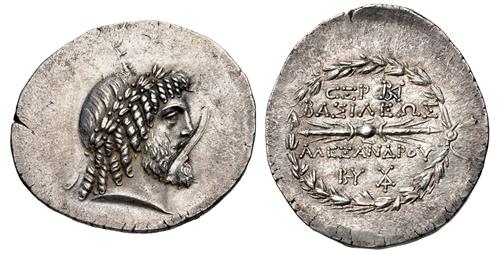|
SELEUKID EMPIRE. Alexander I Balas. 152-145 BC. AR Tetradrachm (35mm, 16.47 g, 3h). Seleukeia Pieria mint. Dated SE 166 (147/6 BC). Laureate head of Zeus to right, with full beard and with his hair arranged in long curls of archaizing form / Thunderbolt; above, ςΞΡ (date) and monogram; below, two monograms; all within laurel wreath with ties to right. SC 1798; HGC 9, 874; DCA 124. Toned, large scrape and die break on obverse. Good VF. Extremely rare. One of approximately fifteen known examples, of which at least seven are in museums.
From the Asher D. Atchick Collection. Ex Classical Numismatic Group Electronic Auction 389 (18 January 2017), lot 340; Classical Numismatic Group Electronic Auction 329 (25 June 2014), lot 178 (hammer $5000); Numismatica Ars Classica 84 (21 May 2015), lot 1557.
This tetradrachm struck by Alexander Balas is among the most intriguing of the Seleukid series. Unlike the usual royal tetradrachm issues that dominate the series, this coin employs types that are directly related to the city in which it was struck. Seleukeia was well noted for its cult of Zeus Casios, and there are also reports that a thunderbolt cult existed there (Appian, Syr. 58). Moreover, the idealized, Pheidian-influenced portrait of Zeus and the winged thunderbolt had been types struck on municipal bronze issues of Seleukeia from the establishment of the city under Seleukos I.
This novel issue is likely a reflection of the prominence of the city under Alexander. At the beginning of his reign, immediately following his overthrow of Demetrios I, Seleukeia was the first city in northern Syria under his total control. In contrast, Antioch refused to accept him, and struck a series of posthumous coins in the name of Antiochos IV. Without having control of the Antioch mint, Alexander was forced to begin striking coinage at Seleukeia, which had been only a peripheral mint in earlier reigns. Although there is no known event in SE 166 that would give rise to such a special coin issue, the purely civic nature of the types strongly suggests that the city retained a level of high prominence during the later years of his reign.
Fewer than ten examples have appeared at auction in the past 20 years.
Closing Date and Time: 8 January 2020 at 11:48:20 ET.
All winning bids are subject to an 18% buyer’s fee.
|
